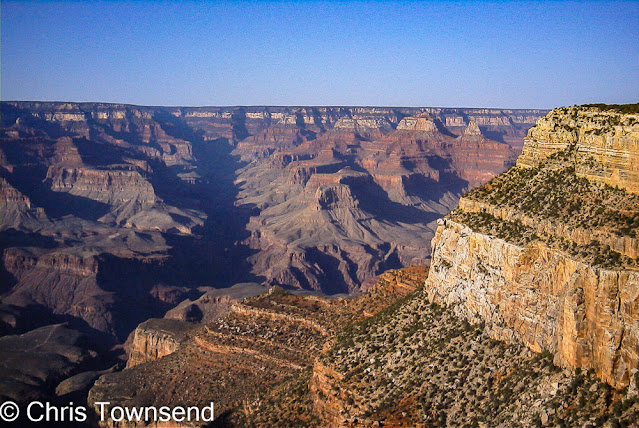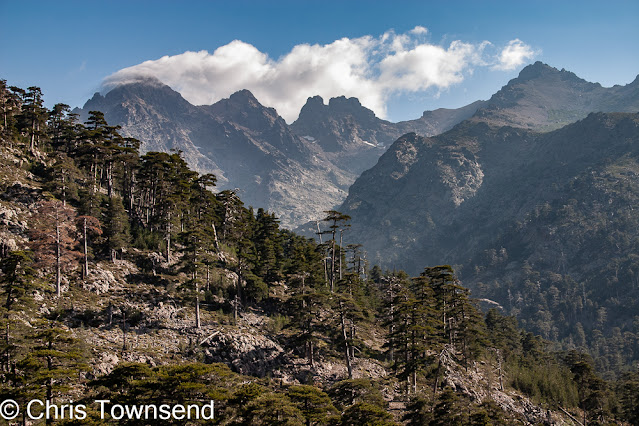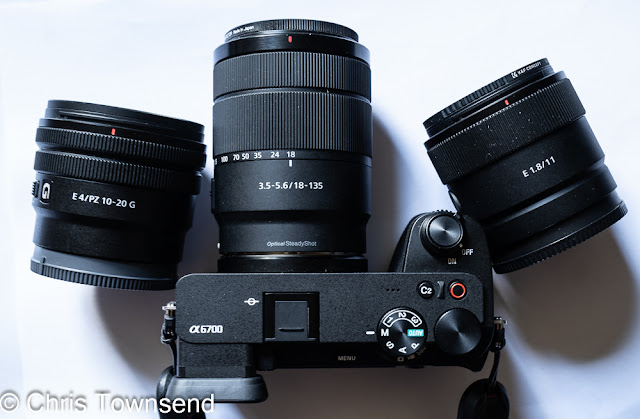 |
| Everest & Lhotse at dawn, October 2005. 6mp Canon 300D, Canon 18-55mm lens at 55mm, ISO 400, f5.6 at 1/160 second. Raw file processed in DXO PhotoLab |
Backpacking with a camera and producing good photographs is a balancing act between performance and weight, especially when you need to produce pictures for publication, as I do. What’s the lightest gear with the best image quality and the most versatility? I’ve been trying to work that out for over forty years! Here, for anyone interested, is a rundown of the camera gear I’ve used on long-distance walks and some of the reasoning behind my choices. Plus a few photos to break up the story.
I first took photography seriously when outdoor magazine editors asked me for pictures to accompany my writing and said no, prints from cheap point-and-shoot cameras were not what they meant. So I bought a second-hand Pentax S1a SLR with 55mm lens and taught myself how to use it. That was a fully manual camera with a separate light meter that could be clipped on the top. I hated the hassle involved in learning how to make it take half-decent photos but it was an excellent way to learn about aperture, shutter speed and focusing.
The editors also said the maximum acceptable ISO speeds (or ASA as it was then) were 64 for colour transparency film and 400 for black-and-white so I had to learn how to hold the camera steady too. Later the acceptable transparency ISO crept up to 100.
Old habits die hard, as the saying goes. I still mostly stick to ISO 100, and I still mostly stick to manual mode for exposure with f8 at 1/125 second my standard setting.
 |
| Mount Shasta, Pacific Crest Trail, 1982. Pentax MX, Pentax 50mm lens. Kodachrome 64 transparency film |
That first SLR was stolen in a burglary and replaced by a lighter one with built-in light meter and automatic exposure options (the Pentax ME Super). Having learnt the limitations of only having one fixed focal length prime lens I did some research (magazines and books – no Internet of course) and found that zoom lenses were not recommended other than in the 75-150 range so I got one of those and a 28mm wide angle prime to supplement the 50mm prime that came with the camera. That combination came with on the Pacific Crest Trail in 1982, along with a second body, the manual Pentax MX. I was to be glad of the latter as the ME Super failed after a few months. I was also glad I had two prime lenses as the zoom was wrecked when it got soaked during a creek crossing. Something that also taught me that my waterproof camera and lens bags were not actually so when submerged.
 |
| The Chinese Wall, Continental Divide Trail, 1985. Pentax MX, Tamron 35-70 lens. Kodachrome 64 transparency film |
I replaced the 75-150 zoom with the same model and changed the prime lenses for a 35-70 zoom that had good reviews for the Continental Divide Trail a few years later. This combination, along with the Pentax MX, survived the walk. Rather than a second body I saved weight by taking a little Olympus XA compact as a back-up camera. This had a 35mm lens.
I missed the 28mm lens on the CDT and so swapped the 35-70 for a 28-70 zoom for my walk the length of the Canadian Rockies in 1988. I also daringly bought a 24mm prime lens – it seemed frighteningly wide at the time – and changed the 75-150 for a 70-210 zoom as longer zooms were getting better reviews than a few years earlier. The MX having failed shortly after the CDT I replaced it with the similar manual Pentax LX and bought a second body, a Pentax Super A, about which I remember nothing! I also carried a tripod for the first time on a long walk, making a total weight of 4.5kg, the heaviest amount of camera gear I’d carried on a long-distance walk. (I wrote about my tripods here. The 281-gram Velbon V-Pod is still my main tripod. I haven’t found anything better at that weight).
 |
| On the Rockwall Trail, Canadian Rockies, 1988. Pentax LX, Tokina 28-70mm lens. Fujichrome 100 transparency film. Tripod essential for this shot. |
A revolution in cameras occurred around this time, the introduction of auto-focus. This had been around since the 1970s but only really took off when Minolta introduced the first SLR with integrated auto-focus in 1985. Other camera makes quickly followed. Having too many blurred shots of animals and birds due to lack of time to focus I could see the advantages. I was also fed up with Pentax bodies failing – the Super A had gone the way of the ME Super and the MX. Nikons were said to be the most durable SLRs so, although I heavier than the Pentaxs, I decided to change. Nikon introduced auto-focus before Pentax too.
My new Nikon cameras were an F801 and an FM2. The first had auto-focus, the second was fully manual. Although heavy the F801 is my favourite of all the film cameras I owned because it had a thirty-second self-timer. The relief of not having just ten seconds to run in front of the camera and try and look normal! I still miss that timer.
 |
| Tombstone Mountain & Talus Lake, Yukon Territory, 1990. Nikon F801, Nikkor 35-70mm lens. Fujichrome 100 transparency film. |
For my walk through the Yukon Territory in 1990 I took 24mm, 35-70mm, and 70-210mm lenses with the Nikon bodies. The weight was a touch less than in the Canadian Rockies
 |
| Lapland, Sweden, Scandinavian Mountains Walk, 1992. Nikon F801, Nikkor 28-70mm lens. Fujichrome 100 transparency film. |
Why not a 28-70mm zoom? I don’t know. Maybe there wasn’t a good one available for Nikon. There must have been two years later as I took one on a length of Scandinavia walk with the other two lenses and the Nikon bodies. And why zoom lenses and not just lighter, smaller fixed focal length prime lenses? I’d found that zooms were just more versatile when hiking and taking photos where there were often few options for “zooming with your feet” because of cliffs, rivers, dense vegetation and more.
 |
| Camp on Stob Coire Easain, Munros & Tops, 1996. Nikon F50, Nikkor 28-70mm lens. Fujichrome 100 transparency film. |
So far, the long walks had all been end-to-end ones, with many sections where the walking was relatively easy. Four years after the Scandinavian walk I set out to walk all the Munros and Tops in the Scottish Highlands, 517 summits over 3,000 feet (914 metres) high. There would be much ascent and descent, often steep, every day, and often not much of anything else. The heavy loads I’d carried on the other walks needed trimming drastically. And that included camera gear. I bought a new, lighter weight Nikon, the F50, and took just the 28-70mm lens., total weight just 907 grams, 1275 grams with padded camera bag. I missed having a longer lens but not the extra weight. I also hated the F50, the worst film SLR I used – no, the worst camera I’ve used. It had tiny, fiddly buttons that were unlabelled, so you had to try and remember what they did. Obviously practise for some digital cameras. Ironically, it’s the only film SLR camera I still have. I’d feel bad passing it on to anyone else.
Digital, of course, was the next big thing happening in the camera world. An enormous thing in fact. I dipped a tentative toe into digital waters in 2000 when I hiked the Arizona Trail. My main camera was a 335-gram Canon 300 SLR – the F50 had put me off lightweight Nikons – with a 24-70mm lens. Film backup was a tiny Ricoh GR1s compact which weighed just 212 grams and had a 28mm lens. I still have this lovely little camera and use it on the very rare occasions I shoot film.
 |
| The Grand Canyon, Arizona Trail, 2000. Ricoh RDC-5000 |
The digital camera was a Ricoh RDC-5000 with a 2.3mp tiny ½” sensor and a zoom lens equivalent to 38-86 in 35mm/full frame. This was quite an advanced digital camera at the time. With its four AA batteries it weighed a fairly hefty 414 grams. It took big Smartcards which I mailed home and which then appeared on a website during the walk. This was a first and seemed amazing at the time. I guess it was.
In the next few years editors started asking for digital images and no, they didn’t mean ones from 2.3mp cameras with tiny sensors. A DSLR with an APS-C size sensor and at least 6mp was needed. APS-C I discovered was the size of an obsolete film format a bit smaller than 35mm. These cameras were very expensive. I swithered for a while. Being told I would only get half the fee for a feature if I could only supply film images made up my mind. As did Canon bringing out the first sub-£1000 DSLR (£999.99!), which was still a great deal of money for a camera in 2004. The 300D came with an 18-55mm lens, equivalent to 27-82mm on 35mm/full frame – multiplying focal lengths by 1.5 is needed because of the smaller sensor. I bought the 300D and my digital era really began.
The 300D only had a 6-megapixel sensor but images from it looked fine. I shot in raw from the start and I’m glad I did as it meant I can now get even better results with the latest processing software like DXO PhotoLab.
 |
| GR20, Corsica, 2005. Canon 300D, 18-55mm lens at 37mm. ISO 200. F8 at 1/125 second. |
For the first few years I still shot film as well, taking both the Canon 300 and 300D on trips such as the trek to Everest Base Camp and the GR20 on Corsica. Digital was obviously the way forward however and I soon gave up film, with, I must admit, great relief. It was always a hassle. Digital photography was so liberating! Especially on long walks. No films to carry, no rationing how many photos I could take as memory cards were so light, no films to send home in small batches in case any were lost on the way. Wonderful! Digital was much easier for publication too. No more carefully packing slides, sending them insured, then checking them when returned for scratches, glue spots, or finger marks (they all occurred).
 |
| Glacier National Park, Pacific Northwest Trail, 2010. Sigma DP1. ISO 50. F5.6 at 1/100 second |
As sensors with more megapixels came out and camera sizes and weights dropped (the 300D was a hefty beast) I changed the 300D for the 8mp 350D and then the 12-mp Canon 450D. I took the latter on the Pacific Northwest Trail in 2010 with the 18-55mm lens. As backup I had a 250g Sigma DP1, the first compact with an APS-C sensor (14-mp), which had a 28mm equivalent lens and took lovely images. This was my first long-distance walk with only digital cameras. It was also my first one with a smartphone, an HTC Desire, with which I took photos to send home for use online and even, quite small, in The Great Outdoors magazine.
The cameras and the PNT didn’t get on that well. The DP1 succumbed to a thunderstorm early on in the walk. The 450D limped to the end though the autofocus failed for the last month. Neither camera was worth repairing. That year the first APS-C mirrorless cameras had appeared, and they were much lighter than DSLRs and so an obvious choice for a new camera. From the four brands then available – Sony, Samsung, Olympus, and Panasonic – I chose the Sony NEX 5 as it felt the most secure to hold and I liked the feel of it. I’ve stuck with that range ever since.
 |
| Loch Trool, Southern Upland Way, 2011. Sony NEX 5 with 18-55mm lens at 55mm. ISO 400. F8 at 1/60 second |
The NEX 5 had a 14mp sensor and came with an 18-55mm lens. It was a good little camera but had one disadvantage. There was no viewfinder. I soon became used to just using a screen, but I never really liked it. It's longest walk was a winter one along the Southern Upland Way. Two years later I changed to the 16-mp NEX 6 and the 24-mp NEX 7 as these did have viewfinders. I also swapped the 18-55mm lens for the much smaller Sony 16-50mm and added the 10-18mm wide angle zoom.
 |
| In the High Sierra, Yosemite to Death Valley, 2016. Sony NEX 7, Sony 10-18mm lens at 10mm. ISO 100. F8 at 1/125 seconds |
Those two lenses and the NEX 7 went on the Scottish Watershed, Yosemite Valley to Death Valley, and GR5 Through the Alps walks. The NEX 6 went on the first of those and was then replaced by the a6000 as it had the same 24-mp sensor as the NEX 7 so image quality was near enough identical.
 |
| Camp in the valley of the Ruisseau de Charmaix, GR5, 2018. Sony a6000, Sony 16-50mm lens at 29mm. ISO 100. F8 at 1/320 second |
I loved that combination as it was small and light and produced excellent images. I did miss a longer lens though and eventually acquired a Sony 18-135mm one (27-205mm equivalent) as it only weighs 325 grams. I took this on a 500-mile Colorado Rockies walk in 2019 instead of the 16-50mm and took many animal photographs I could never have taken with the latter. It’s now my favourite lens and the best I’ve used for backpacking.
 |
| Moose, Colorado Rockies, 2019. Sony a6000, Sony 18-135mm lens at 135mm. ISO 400. F8 at 1/50 second |
This year I’ve replaced the ageing and battered NEX 7 and a6000 cameras with the a6600 and a6700, which take larger batteries that last much longer, and, for the first time with any of my cameras, have built-in stabilisation and weather-sealing. The a6700 in particular has many other advantages and is the best mirrorless camera I’ve used. It weighs 589 grams with battery, memory card and Peak Designs Leash. I also have two new small ultralight lenses -the 229-gram Sony 11mm and 205-gram Sony 10-20mm - as these are also weather-sealed, unlike the lenses they replaced. The 18-135 isn’t weather-sealed but there isn’t an equivalent that is, so it remains my main lens. The total weight of the bodies and lenses plus padded bags is 2.56kg. If I only carry the a6700 and the lenses in a Billingham Hadley Digital Bag (they all easily fit inside) the weight is 1.9kg.
 |
| Sony a6700, Sony 11mm, 10-20mm & 18-135mm lenses. Sony a6600 with Sony 30mm macro lens. ISO 400. F5.6 at 1/8 second. |
A week after writing this I’m off for a two-week autumn walk in the Cairngorms. It’ll be the first long trip with my new camera set-up. I’ll be posting pictures.
If you want to read even more about my new camera gear and the reasons I chose it see here, here and here.

Thanks Chris! Still enjoying the 6700? I trying to decide on a good camera for hiking, often using a Rx100vii, but would like to update. Perhaps this or an OM 5.
ReplyDeleteYes, I'm delighted with the a6700. I think it will be my main camera for quite a while.
Delete